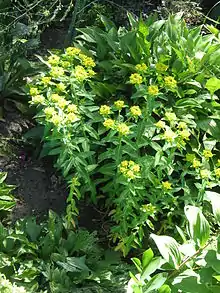Euphorbia schillingii
Euphorbia schillingii, or Schilling spurge, is a species of flowering plant in the spurge family Euphorbiaceae, native to Nepal. Growing to 1 m (3.3 ft) tall by 0.5 m (1.6 ft) broad, it is an herbaceous perennial bearing long, narrow leaves with a prominent white midrib, and clusters of long-lasting lime-green flowers throughout summer into autumn. The flowers are useful in flower arranging.[2]
| Euphorbia schillingii | |
|---|---|
 | |
| Scientific classification | |
| Kingdom: | Plantae |
| Clade: | Tracheophytes |
| Clade: | Angiosperms |
| Clade: | Eudicots |
| Clade: | Rosids |
| Order: | Malpighiales |
| Family: | Euphorbiaceae |
| Genus: | Euphorbia |
| Species: | E. schillingii |
| Binomial name | |
| Euphorbia schillingii Radcl. -Sm.[1] | |
The Latin specific epithet schillingii honours its finder, the plant hunter Tony Schilling (born 1935).[3]
In cultivation it grows best in rich, moist soil in a partially-shaded location. It is hardy down to −15 °C (5 °F) (surviving even harsh winters in the UK) reflecting its origin in the Himalayas. It has gained the Royal Horticultural Society’s Award of Garden Merit.[4][5]
All euphorbias are toxic if ingested, and produce an irritant milky sap when cut or broken.[4]
References
- "Euphorbia schillingii Radcl. -Sm". The Plant List. Retrieved 25 February 2018.
- "Euphorbia schillingii". BBC. Retrieved 25 February 2018.
- Harrison, Lorraine (2012). RHS Latin for Gardeners. United Kingdom: Mitchell Beazley. ISBN 978-1845337315.
- "RHS Plantfinder - Euphorbia schillingii". Retrieved 25 February 2018.
- "AGM Plants - Ornamental" (PDF). Royal Horticultural Society. July 2017. p. 38. Retrieved 25 February 2018.